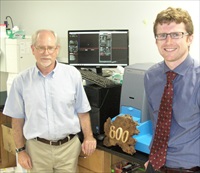Members Login

Channels
Special Offers & Promotions
Published papers endorse NanoSight technology
NanoSight, world-leading providers of unique nanoparticle characterization technology, announces that more than 800 third party publications citing their Nanoparticle Tracking Analysis (NTA) methodology have been published, and reflect on the significance of this powerful third party endorsement.
 May 2013 saw publication of the 800th peer-reviewed paper citing NTA. It was written by Mark Davis and his group at Caltech: "Transcytosis and brain uptake of transferrin-containing nanoparticles by tuning avidity to transferrin receptor." It was published in the Proceedings of the National Academy of Sciences of the United States of America.
May 2013 saw publication of the 800th peer-reviewed paper citing NTA. It was written by Mark Davis and his group at Caltech: "Transcytosis and brain uptake of transferrin-containing nanoparticles by tuning avidity to transferrin receptor." It was published in the Proceedings of the National Academy of Sciences of the United States of America.
Since the first papers referencing NTA appeared in 2006, the rate of publication has grown exponentially. The proportion of papers within Life Sciences has grown most rapidly, from 30% in the early years to more than 80% today. This bias is driven by the match between NanoSight's multiparameter characterization capability and the complexity and natural variability of biological and botanical samples. "Publications are largely from academic users; commercial concerns remain more guarded about applications, for good business reasons. With these users, primarily in the pharmaceutical industries, we do have to work harder to understand their applications and future needs," commented Jeremy Warren, NanoSight's CEO.
Since NanoSight began sales in earnest in 2006, uptake has been rapid; today the instrument population exceeds 600 with more than 90% of sales outside the UK. Providing instruments is just the start of the adoption process. Only when users validate the usefulness of new measurands can the potential of any new technology be fully appreciated.
"User endorsement carries far more weight than anything we could say about NTA" says NanoSight's Head of Development, Dr Patrick Hole. "Users tell colleagues in the same field about NanoSight's utility, and that is emphasized best when a paper is published. Peers see this information together with the value that the characterization provides along with a record of the methodologies employed."
Applications range from drug delivery system and aggregation of protein therapeutics to legislation-driven nanomaterials detection and study of exosomes. Exosomes are biologically derived nanoparticles whose enormous potential in cancer and other diagnostics is driving a burgeoning sector of scientific research.
For Warren, papers provide horsepower to the innovation and development processes. He comments "Fundamental to our business is the development of new applications. Within the miscellany of unique applications of NanoSight instrumentation sit occasional nuggets of gold. These are the applications that tick all the boxes: the data NanoSight supplies is unique, it is extremely valuable to the user and the sector is large and growing. Users bring these to us; our task is to listen."
New applications aside, papers represent development effort. Warren adds "reflect for a moment on hundreds of research groups' writing papers. In 2013 this will represent tens of thousands of laboratory hours from PhD-level scientists, with their NanoSight work continuing to advance research and development." Warren concludes "The publication rate continues upward and, if current trends continue, 2013 will see papers reach the 1,000 mark. Now that will be a milestone to celebrate."
Media Partners


